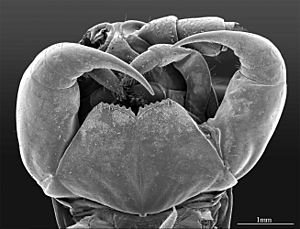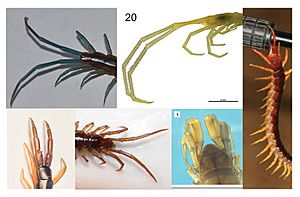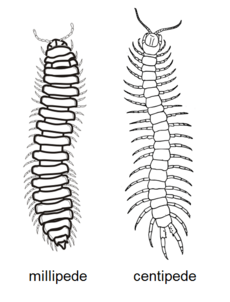Centipede facts for kids
Quick facts for kids Centipede |
|
|---|---|
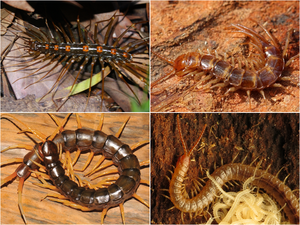 |
|
| Various centipedes (clockwise from top left): Thereuopoda clunifera, a Scutigeromorph; Lithobius forficatus, a Lithobiomorph; Geophilus, a Geophilomorph; and Scolopendra cataracta, a Scolopendromorph | |
| Scientific classification |
|
| Kingdom: | Animalia |
| Phylum: | Arthropoda |
| Subphylum: | Myriapoda |
| Class: | Chilopoda Latreille, 1817 |
| Orders and suborders | |
|
|
Centipedes (from New Latin centi-, "hundred", and Latin pes, pedis, "foot") are predatory arthropods belonging to the class Chilopoda (Ancient Greek χεῖλος, kheilos, lip, and New Latin suffix -poda, "foot", describing the forcipules) of the subphylum Myriapoda, an arthropod group which includes millipedes and other multi-legged animals.
Centipedes are elongated creatures with one pair of legs per body segment. All centipedes are venomous and can inflict painful bites. Despite the name, no centipede has exactly 100 pairs of legs; they can have a varying number of legs, ranging from 15 pairs to 191 pairs, always an odd number. They are predominantly carnivorous.
Centipedes have a wide geographical range, and are found in terrestrial habitats from tropical rainforests to deserts. Within these habitats, centipedes require a moist microhabitat because they lack the waxy cuticle of insects and arachnids, therefore causing them to rapidly lose water. Accordingly, they avoid direct sunlight by staying under cover or by being active at night.
Contents
Description
Centipedes have a rounded or flattened head, bearing a pair of antennae at the forward margin. They have a pair of elongated mandibles, and two pairs of maxillae. The first pair of maxillae form the lower lip, and bear short palps. The first pair of limbs stretch forward from the body over the mouth. These limbs, or forcipules, end in sharp claws and include venom glands that help the animal to kill or paralyze its prey. Their size ranges from a few millimetres in the smaller lithobiomorphs and geophilomorphs to about 30 cm (12 in) in the largest scolopendromorphs.
Sensory organs
Many species of centipedes lack eyes, but some possess a variable number of ocelli, sometimes clustered together to form true compound eyes. However, these eyes are only capable of discerning light from dark, and provide no true vision. In some species, the first pair of legs can function as sensory organs, similar to antennae; unlike the antennae of most other invertebrates, these point backwards. An unusual clustering of sensory organs found in some centipedes is the organ of Tömösváry. The organs, at the base of the antennae, consist of a disc-like structure and a central pore, with an encircling of sensitive cells. They are likely used for sensing vibrations, and may provide a weak form of hearing.
Forcipules
Forcipules are unique to centipedes. The forcipules are modifications of the first pair of legs (the maxillipeds), forming a pincer-like appendage, just behind the head. Forcipules are not oral mouthparts, though they are used to subdue prey by injecting venom and gripping the prey animal. Venom glands run through a tube, from inside the head to the tip of each forcipule.
Body
Behind the head, the body consists of at least fifteen segments. Most of the segments bear a single pair of legs; the maxillipeds project forward from the first body segment, while the final two segments are small and legless. Each pair of legs is slightly longer than the pair preceding them, ensuring that they do not overlap, which reduces the chance that they will collide and trip the animal. The last pair of legs may be as much as twice the length of the first pair. The final segment bears a telson, and includes the openings of the reproductive organs.
Centipedes mainly use their antennae to seek out their prey. The digestive tract forms a simple tube, with digestive glands attached to the mouthparts. Like insects, centipedes breathe through a tracheal system, typically with a single opening, or spiracle, on each body segment. They excrete waste through a single pair of malpighian tubules.
Ultimate legs
Just as the first pair of legs are modified into forcipules, the back legs are modified into "ultimate legs", caudal legs, and terminal legs. Their use varies between species, but does not include locomotion. The ultimate legs may be elongated and thin, thickened, or pincer-like. They are frequently sexually dimorphic, and may play a role in mating rituals. Because glandular pores occur more frequently on ultimate legs than on the "walking" legs, they may serve a sensory role. They are sometimes used in defensive postures, and some species use them to capture prey, defend themselves against predators, or suspend themselves from objects such as branches, using the legs as pincers. Several species use their ultimate legs upon encountering another centipede, trying to grab the body of the other centipede.
Members of the genus Alipes can stridulate their leaf-like ultimate legs to distract or threaten predators. Rhysida immarginata togoensis makes a faint creaking sound when it swings its ultimate legs.
Distinction from millipedes
Scholars have noted that disinformation exists about the difference between millipedes and centipedes, and they seek to provide more generalized information for education purposes. Both groups of myriapods have long, multi-segmented bodies, many legs, a single pair of antennae, and the presence of postantennal organs. Centipedes have one pair of legs per segment, while millipedes have two. Their heads differ in that millipedes have short, elbowed antennae, a pair of robust mandibles and a single pair of maxillae fused into a lip; centipedes have long, threadlike antennae, a pair of small mandibles, two pairs of maxillae and a pair of large venom claws.
| Trait | Millipedes | Centipedes |
|---|---|---|
| Legs | Two pairs on most body segments; attached to underside of body | One pair per body segment; attached to sides of body; last pair extends backwards |
| Locomotion | Generally adapted for burrowing or inhabiting small crevices; slow-moving | Generally adapted for running, except for the burrowing soil centipedes |
| Feeding | Primarily detritivores, some herbivores, few carnivores; no venom | Primarily carnivores with front legs modified into venomous fangs |
| Spiracles | On underside of body | On the sides or top of body |
| Reproductive openings | Third body segment | Last body segment |
| Reproductive behaviour | Male generally inserts spermatophore into female, using his gonopods | Male produces spermatophore that is usually picked up by female |
Lifecycle
Reproduction
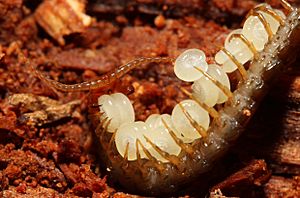
In temperate areas, egg laying occurs in spring and summer. Females provide parental care, both by curling their bodies around eggs and young, and by grooming them, probably to remove fungi and bacteria.
Centipedes are longer-lived than insects; the European Lithobius forficatus may live for 5 to 6 years, and the wide-ranging Scolopendra subspinipes can live for over 10 years. The combination of a small number of eggs laid, long gestation period, and long time of development to reproduction has led authors to label lithobiomorph centipedes as K-selected.
Development
Centipedes grow their legs at different points in their development. For example, Scutigera coleoptrata, the house centipede, hatches with only four pairs of legs and in successive moults has 5, 7, 9, 11, 15, 15, 15 and 15 pairs respectively, before becoming a sexually mature adult. All mature lithobiomorph centipedes have 15 leg-bearing segments.
The total number of pairs begins and remains odd throughout development, so there are never exactly 100 pairs, despite the group's common name.
Ecology
Diet
Centipedes are predominantly generalist predators. They are adapted to eat a broad range of prey, including lumbricid earthworms, dipteran fly larvae, and collembolans. They are carnivorous; study of gut contents suggests that plant material is an unimportant part of their diets, although they eat vegetable matter when starved during laboratory experiments.
Scolopendromorphs, given their size, are able to feed on both invertebrates and vertebrates. Scolopendra gigantea, the Amazonian giant centipede, preys on large invertebrates including tarantulas and scorpions, and vertebrates including lizards, frogs, birds, mice, and even bats, catching them in midflight. Three species (Scolopendra cataracta, S. paradoxa, and S. alcyona) are amphibious, and are believed to hunt aquatic or amphibious invertebrates.
Predators
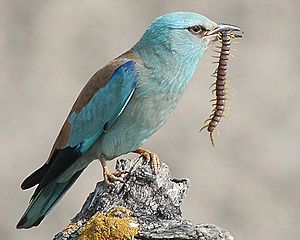
Many larger animals prey upon centipedes, such as mongooses, mice, salamanders, beetles and snakes. They form an important item of diet for many species and the staple diet of some such as the African ant Amblyopone pluto, which feeds solely on geophilomorph centipedes, and the South African Cape black-headed snake Aparallactus capensis.
Defences
Some Geophilomorph, Lithobiomorph, and Scolopendromorph centipedes produce sticky, toxic secretions to defend themselves. The various secretions ward off or entangle predators. Scolopendromorph secretions contain hydrogen cyanide.
Among Geophilomorphs, the secretions of Geophilus vittatus are sticky and odorous, and contain hydrogen cyanide.
The giant desert centipede of Arizona, Scolopendra polymorpha, has a black head and tail, and an orange body; this conspicuous pattern may be aposematic, an honest signal of the animal's toxicity. Many species raise and splay their ultimate legs and display the spines found on the legs in a defensive threat posture.
Habitat and behaviour
Because centipedes lack the waxy water-resistant cuticle of other arthropods, they are more susceptible to water loss via evaporation. Thus, centipedes are most commonly found in high-humidity environments to avoid dehydration, and are mostly nocturnal.
Centipedes live in many different habitats including in soil and leaf litter; they are found in environments as varied as tropical rain forests, deserts, and caves. Some geophilomorphs are adapted to littoral habitats, where they feed on barnacles.
Threatened species
As of the 2019 IUCN Red List, there are two vulnerable and one endangered species of centipede: the Serpent Island centipede (Scolopendra abnormis), Turk's earth centipede (Nothogeophilus turki), and the Seychelles long-legged centipede (Seychellonema gerlachi), the first two of which are vulnerable and the last endangered.
Evolution of venoms
All centipedes are venomous. Over the first 50 million years of the clade's evolutionary history, centipede venoms appear to have consisted of a simple cocktail of about four different components, and differentiation into specific venom types appears to have only occurred after the currently recognized five orders had developed. The evolution of the venom includes horizontal gene transfer, involving bacteria, fungi and oomycetes.
Interaction with humans
As food

As a food item, certain large-sized centipedes are consumed in China, usually skewered and grilled or deep fried. They are often seen in street vendors’ stalls in large cities, including Donghuamen and Wangfujing markets in Beijing.
Hazard
Some species of centipedes can be hazardous to humans because of their bite. While a bite to an adult human is usually very painful and may cause severe swelling, chills, fever, and weakness, it is unlikely to be fatal. Bites can be dangerous to small children and those with allergies to bee stings. The venomous bite of larger centipedes can induce anaphylactic shock in such people. Smaller centipedes are generally incapable of piercing human skin.
Even small centipedes that cannot pierce human skin are considered frightening by some humans due to their dozens of legs moving at the same time and their tendency to dart swiftly out of the darkness towards one's feet. A 19th-century Tibetan poet warned his fellow Buddhists, "if you enjoy frightening others, you will be reborn as a centipede."
See also
 In Spanish: Ciempiés para niños
In Spanish: Ciempiés para niños


